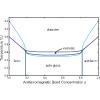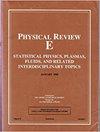Axial, planar-diagonal, body-diagonal fields on the cubic-spin spin glass in d=3: A plethora of ordered phases under finite fields
IF 2.4
3区 物理与天体物理
Q1 Mathematics
引用次数: 0
Abstract
A nematic phase, previously seen in the classical Heisenberg spin-glass system, occurs in the -component cubic-spin spin-glass system, between the low-temperature spin-glass phase and the high-temperature disordered phase, for number of spin components , in spatial dimension , thus constituting a liquid-crystal phase in a dirty (quenched-disordered) magnet. Furthermore, under application of a variety of uniform magnetic fields, a veritable plethora of phases is found. Under uniform magnetic fields, 17 different phases and two spin-glass phase diagram topologies (meaning the occurrences and relative positions of the many phases), qualitatively different from the conventional spin-glass phase diagram topology, are seen. The chaotic rescaling behaviors and their Lyapunov exponents are calculated in each of these spin-glass phase diagram topologies. These results are obtained from renormalization-group calculations that are exact on the hierarchical lattice and, equivalently, approximate on the cubic spatial lattice. Axial, planar-diagonal, or body-diagonal finite-strength uniform fields are applied to and 3 component cubic-spin spin-glass systems in .

d=3立方自旋玻璃上的轴、平面对角、体对角场:有限场下的大量有序相位
以前在 d=3 经典海森堡自旋玻璃体系中出现过的向列相,在空间维度 d=3 的 n 分立方自旋自旋玻璃体系中出现,介于低温自旋玻璃相和高温无序相之间(自旋成分数 n≥3 时),从而构成了肮脏(淬火-无序)磁体中的液晶相。此外,在各种均匀磁场的作用下,还发现了名副其实的大量相。在均匀磁场下,可以看到 17 种不同的相和两种自旋玻璃相图拓扑(指多种相的出现和相对位置),与传统的自旋玻璃相图拓扑有本质区别。计算了每种自旋玻璃相图拓扑中的混沌重定标行为及其 Lyapunov 指数。这些结果是通过重正化群计算获得的,重正化群计算在 d=3 分层晶格上是精确的,而在立方空间晶格上则是近似的。轴向、平面对角或体对角有限强度均匀场应用于 d=3 的 n=2 和 3 分立方自旋玻璃系统。
本文章由计算机程序翻译,如有差异,请以英文原文为准。
求助全文
约1分钟内获得全文
求助全文
来源期刊

Physical review. E
物理-物理:流体与等离子体
CiteScore
4.60
自引率
16.70%
发文量
0
审稿时长
3.3 months
期刊介绍:
Physical Review E (PRE), broad and interdisciplinary in scope, focuses on collective phenomena of many-body systems, with statistical physics and nonlinear dynamics as the central themes of the journal. Physical Review E publishes recent developments in biological and soft matter physics including granular materials, colloids, complex fluids, liquid crystals, and polymers. The journal covers fluid dynamics and plasma physics and includes sections on computational and interdisciplinary physics, for example, complex networks.
 求助内容:
求助内容: 应助结果提醒方式:
应助结果提醒方式:


